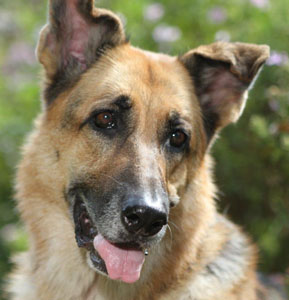
Dr. Phil Zeltzman is a mobile, board-certified surgeon in Allentown, PA. Find him online at www.DrPhilZeltzman.com. He is the co-author of “Walk a Hound, Lose a Pound” (www.WalkaHound.com).
Kelly Serfas, a Certified Veterinary Technician in Bethlehem, PA, contributed to this article.
 Late one frigid winter evening, as I was considering finally going to bed after a long surgery day, I received a worried call from my friends Sandy and Bill. Zada, a former patient, was in trouble. The 9-year old German shepherd, a former therapy dog, was bleeding internally.
Late one frigid winter evening, as I was considering finally going to bed after a long surgery day, I received a worried call from my friends Sandy and Bill. Zada, a former patient, was in trouble. The 9-year old German shepherd, a former therapy dog, was bleeding internally.
Zada had shown a sudden decline in energy and appetite. Sandy had wisely taken her to her family vet for blood work and an ultrasound. The conclusion: she had a large mass on her spleen, which was bleeding internally, filling her belly with blood. That was making her weak and anemic (a low red blood cell count). So they were referred to a local emergency clinic, and that’s where they called from.
By then, the emergency vet had started a blood transfusion. To my surprise, surgery, the only way to stop the bleeding, was not offered. In fact, she had recommended euthanasia several times. She obviously didn’t know Sandy and Bill, who don’t give up so easily. Their love, dedication and commitment are simply unmatched... but that didn't seem to matter.
The new plan was to transfer Zada to another emergency hospital, about an hour away, where I often performed surgery. I also would drive an hour to meet them there.
The blood transfusion had done little to help, as Zada’s mass was still bleeding. Surgery was her only hope and we all wanted to give her every chance. By the time we all met at the hospital, the ER crew was in full gear, ready to promptly anesthetize Zada, clip her belly, transfer her to the OR, hook her up to monitoring equipment and start surgery. It was teamwork at its best.
Zada's surgery began around 1 a.m. We removed the spleen, which contained a fist sized, bleeding mass. Sadly, there were other masses in the liver and throughout the belly. Amazingly, we also removed two quarts of blood from the belly. This is a huge amount, even in a 74-pound dog. Surgery was over by 2 am. Despite the grim findings, Zada did remarkably well throughout surgery and anesthesia.
She was closely monitored by the ER crew for the rest of the night and was quickly back to her normal sweet, happy disposition. She even ate some salmon-flavored food the next morning! Zada went home the same evening. Everybody was thrilled. Zada was saved – for now.
After a week, the pathologist reported what I had suspected and prepared my friends for. Zada had hemangiosarcoma, an aggressive cancer which had already spread throughout her belly. They had accepted the diagnosis and because Zada seemed so full of energy, decided to try chemotherapy. Although chemo typically has fewer side-effects in pets than people, it made Zada quite sick, so we decided to stop after one round. Our new goal was to help Zada remain comfortable for as long as possible.
The next few weeks and months went very well. Zada was happy, energetic and eating well. Until the situation suddenly changed. Her appetite decreased. Her red blood cell dropped. Her energy faded. It was time…
Zada was eventually put to sleep. It was the right thing to do.
Once the shock was over, I asked Sandy and Bill some grueling questions: “So was it all worth it? Did we do the right thing?”
Sandy’s response: “ABSOLUTELY !!!!! We had time to prepare and say goodbye… Through all this, she only really had one bad day, and that was the day she passed away. Every extra day we spent with her was worth it. All the money we spent on her was worth it. Every chemo drop, every ultrasound, every red blood cell count was worth it. You gave us time to prepare for her death. For that we are eternally grateful. That was priceless.”
If you have any questions or concerns, you should always visit or call your veterinarian – they are your best resource to ensure the health and well-being of your pets.
